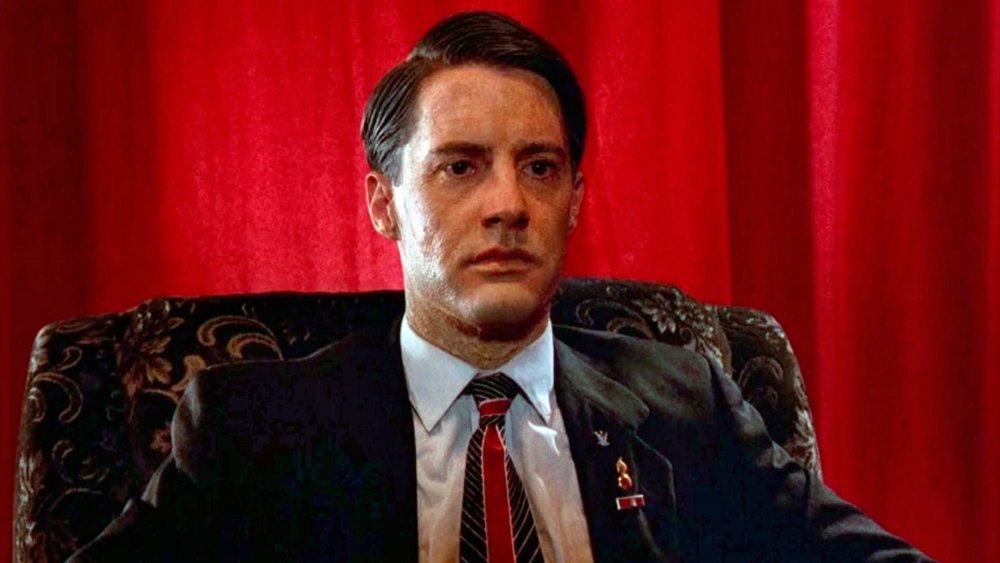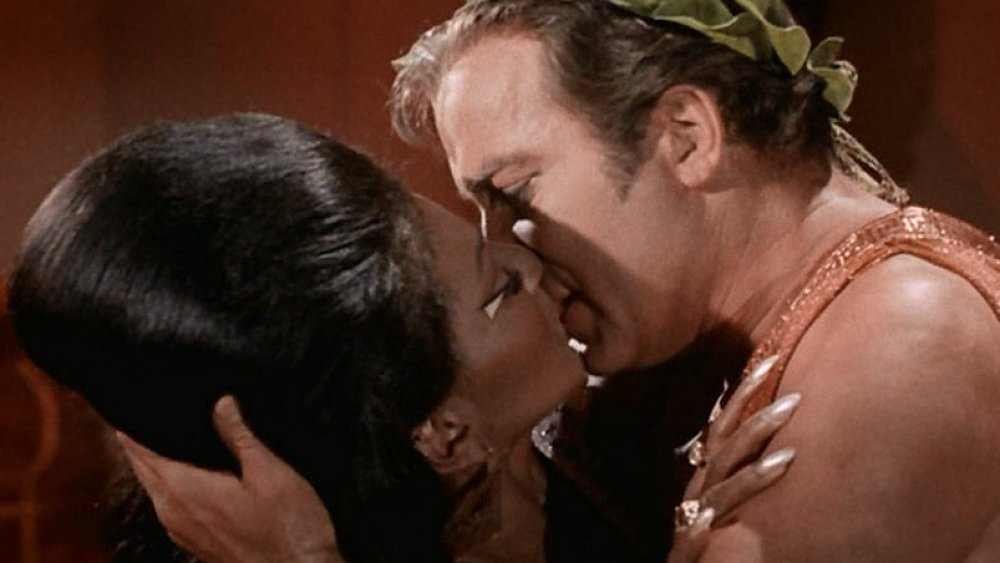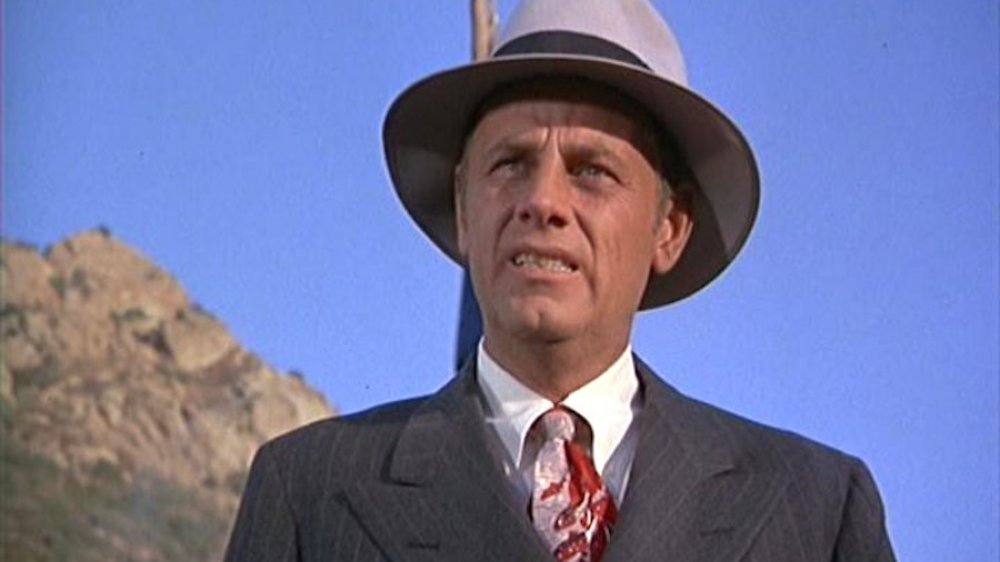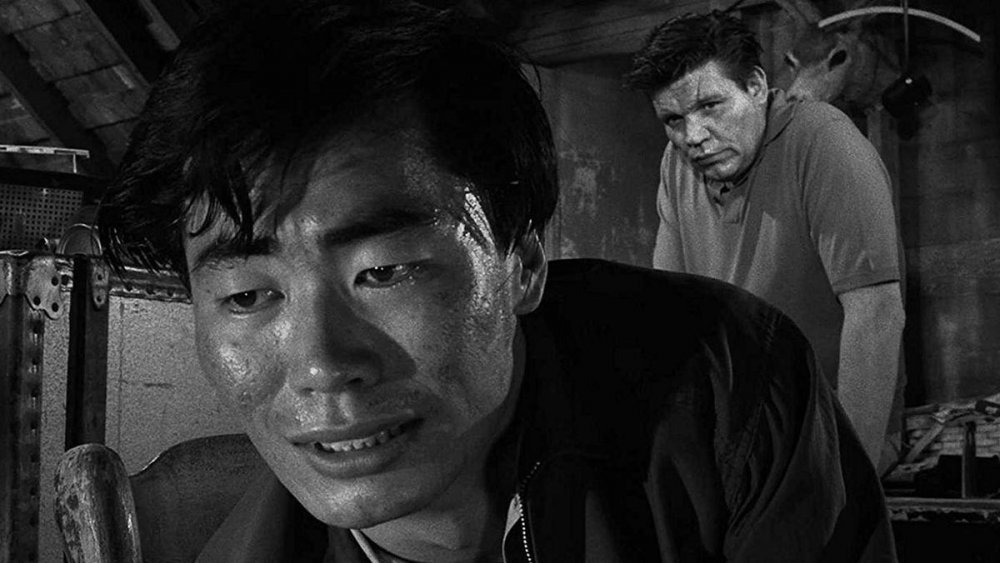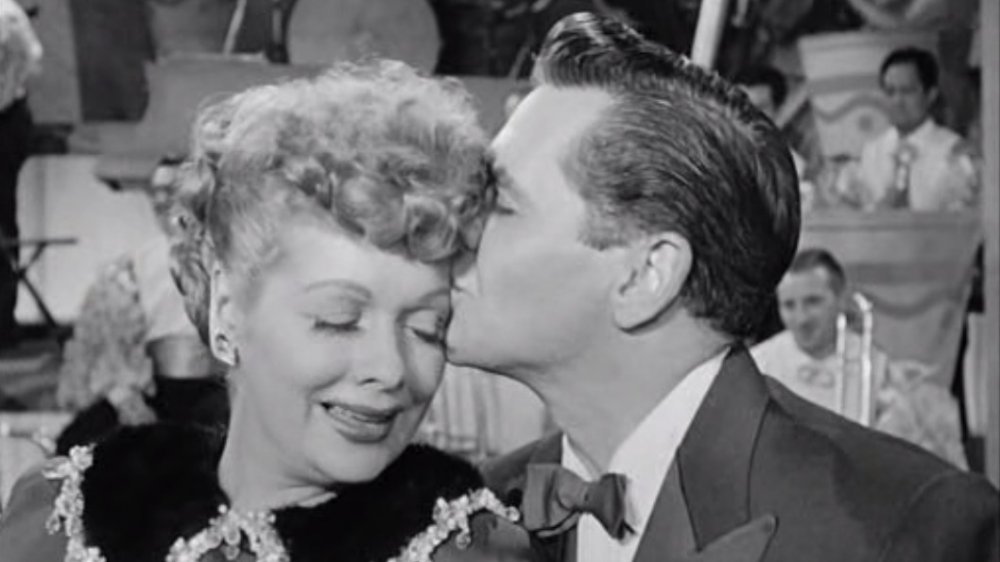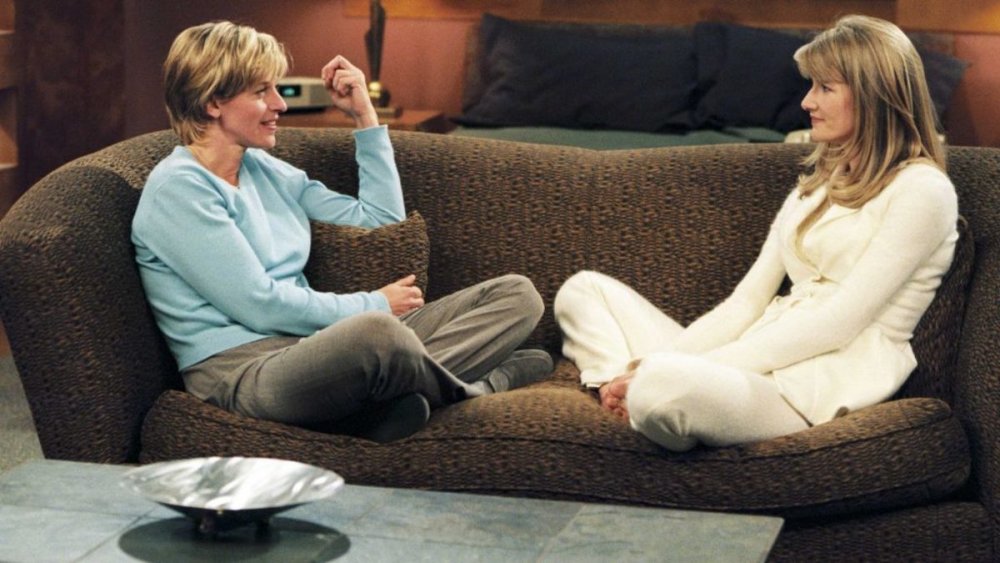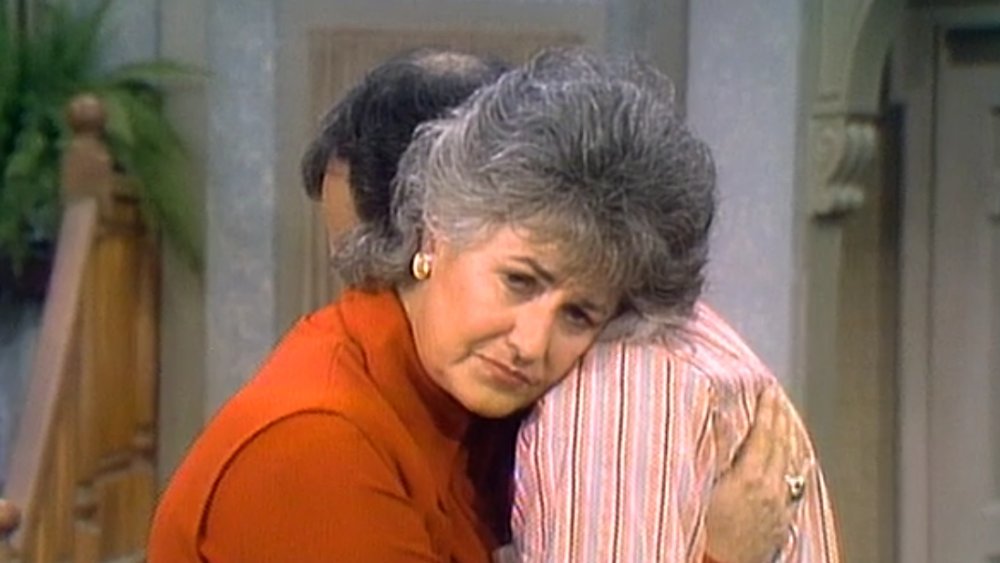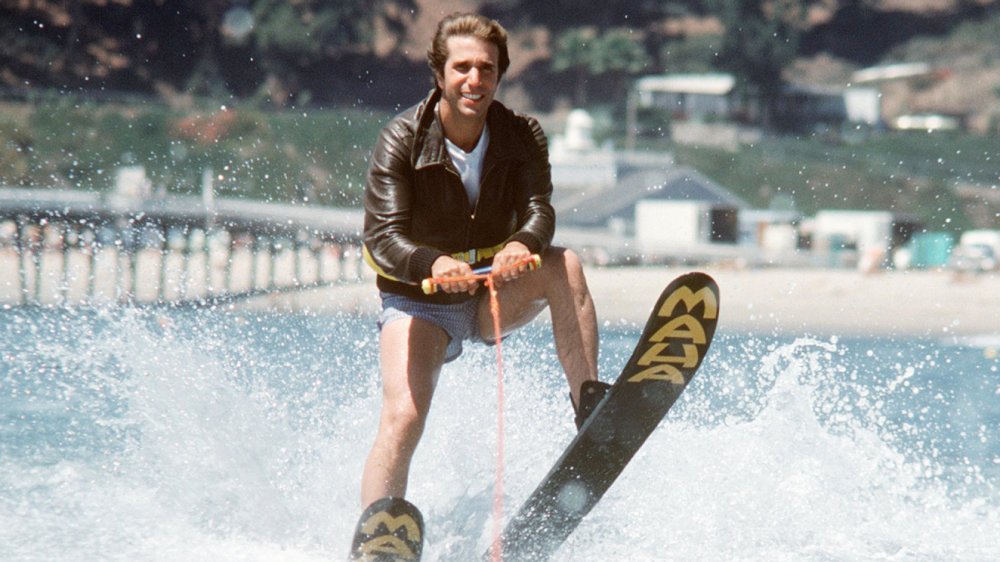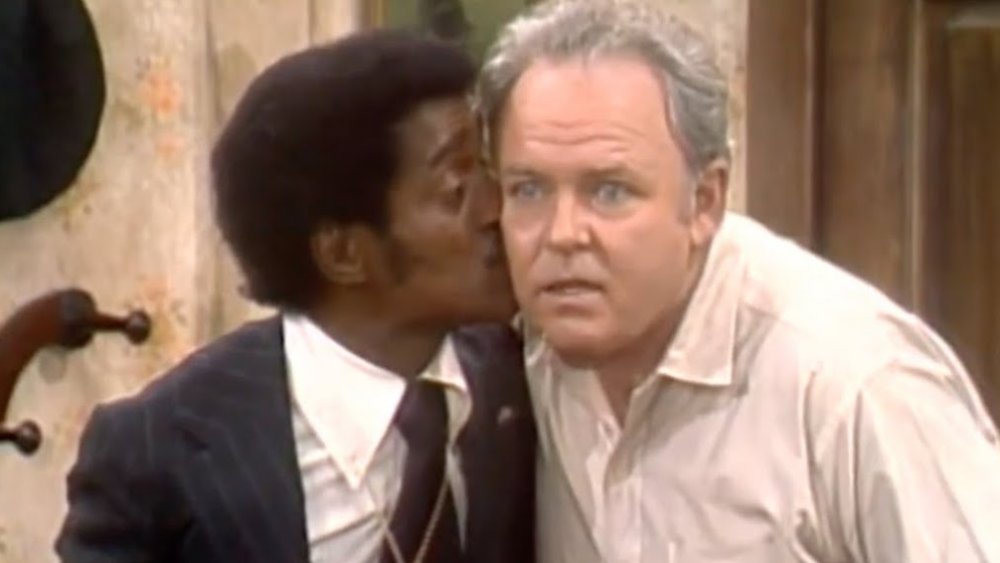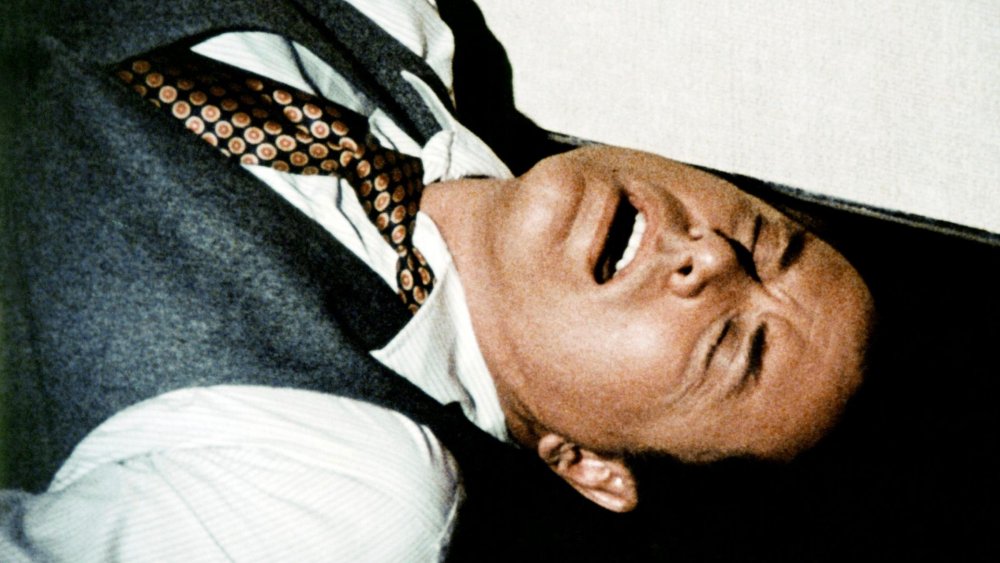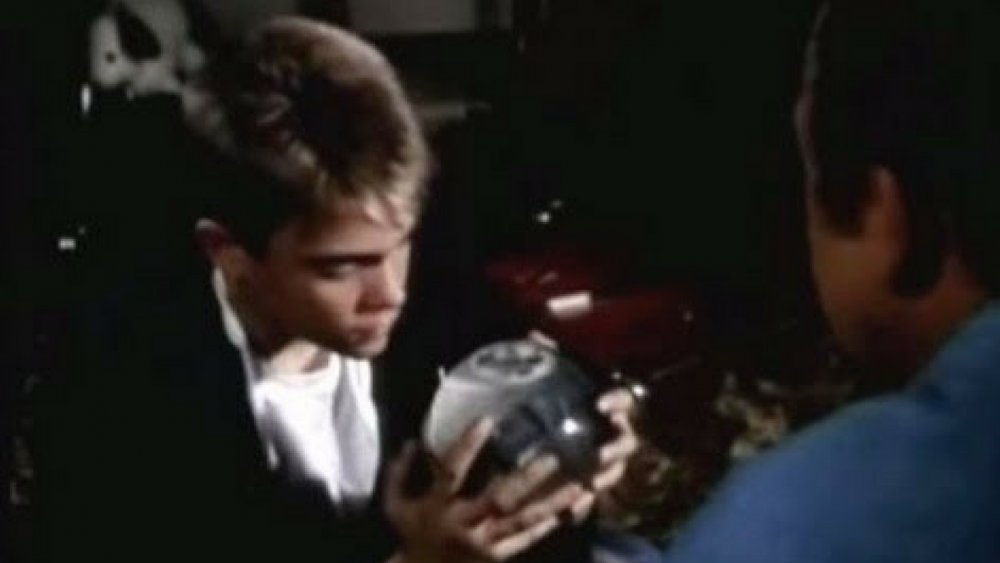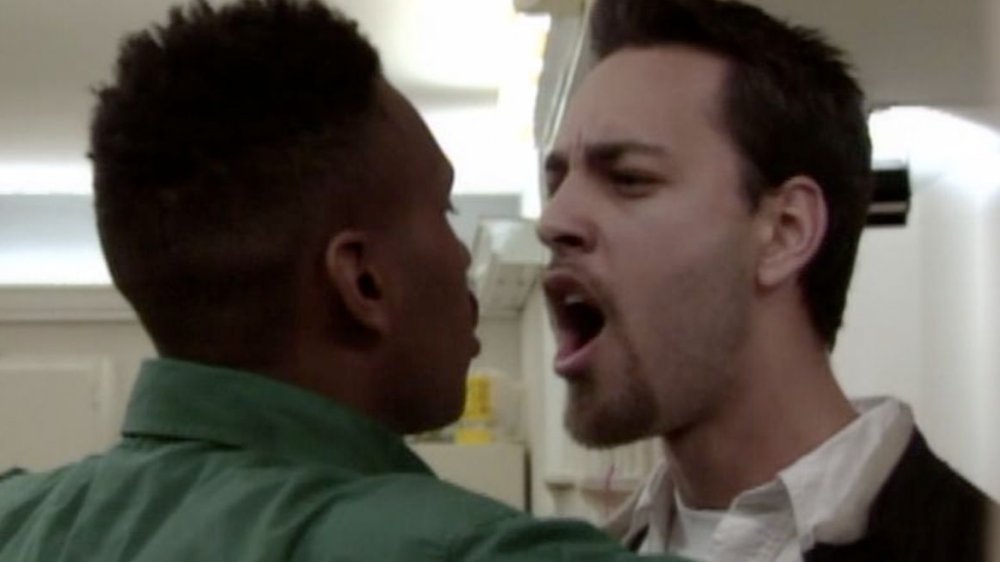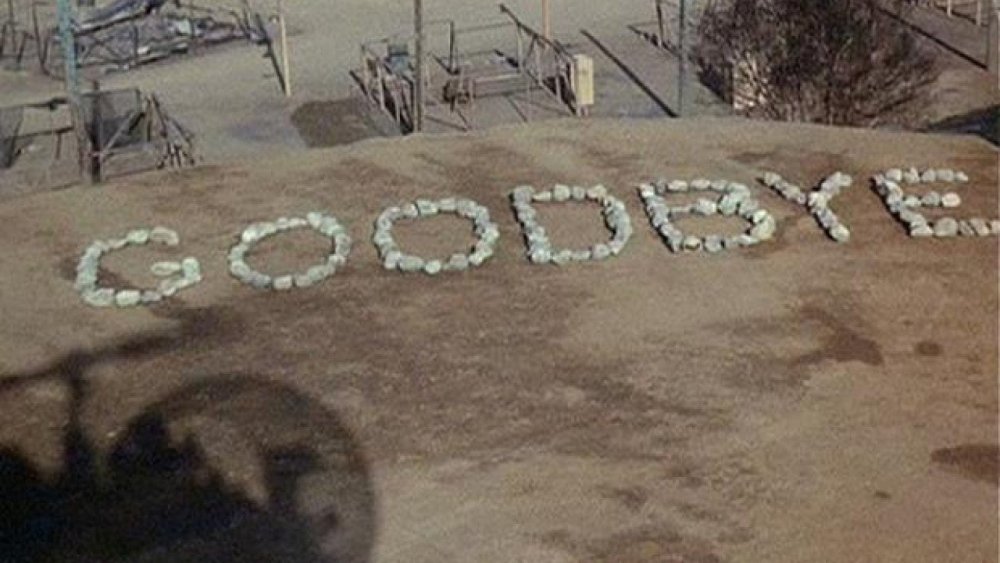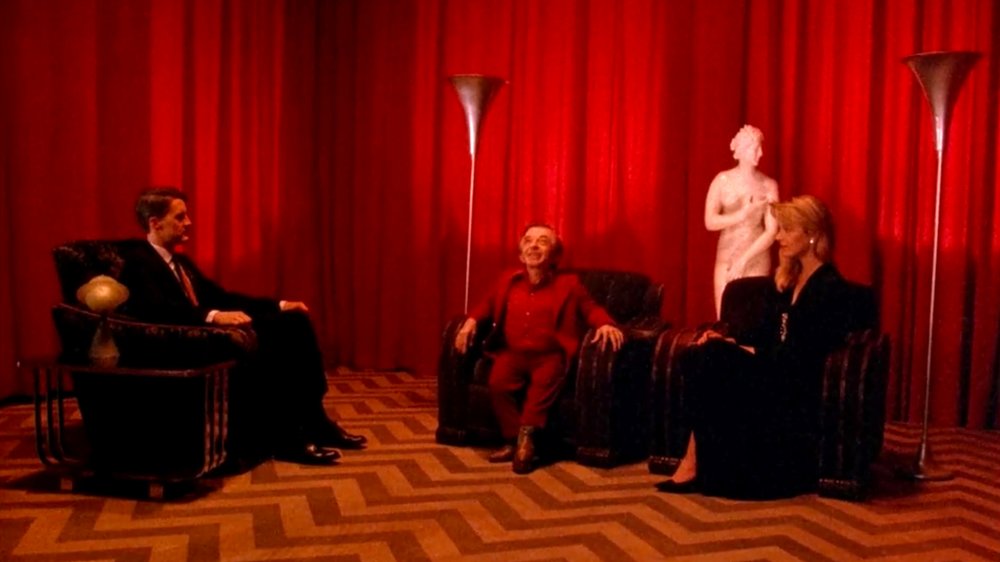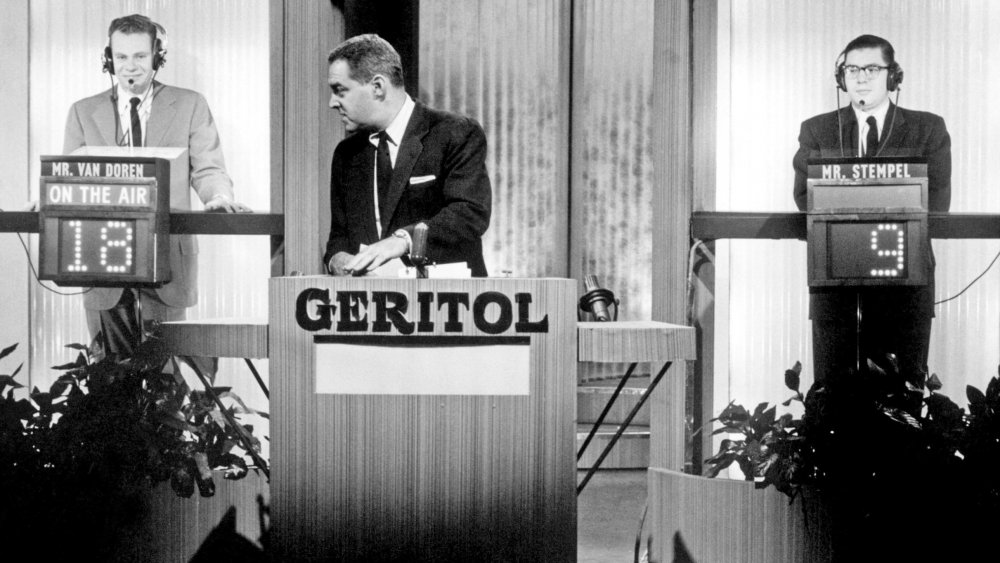TV Show Moments That Made History
Despite decades of parents and teachers trying to tell us that TV will rot our brains, it's hard to deny the incredible impact that the invention of "the tube" has had on society. Now more than ever, we're deeply plugged into media, with streaming services vying for our attention with every click of the cursor or tap of our smartphone screens. But not too long ago, television alone — whether cable or broadcast — was the main source of news and entertainment for the average American. While we can now pick and choose the media we consume, past generations were more restricted in their options, and television shows were a major source of education, information, and controversy. As a result, some TV show moments actually helped make and change history, serving as a pivotal part of fueling discussion, offering different perspectives, and igniting the imagination of a nation.
Star Trek the Original Series: Plato's Stepchildren
Gene Roddenberry's science fiction classic Star Trek has had a profound effect on the world since it debuted in 1966. Roddenberry had an idealized image of the future, one in which mankind has laid aside all petty squabbles, achieved world peace, and seeks to maintain that peace in the rest of the universe — and beyond.
Though Star Trek was admittedly imperfect in its approach to this utopian vision, it did some things extremely well, including casting the incomparable Nichelle Nichols as translator and communications officer Nyota Uhura. Uhura was notably one of the first non-menial roles for a Black actor on television at the time, an important part of the Enterprise's multicultural crew. In the 1968 episode "Plato's Stepchildren," Uhura and Captain Kirk are under the mind control of an alien race known as the Platonians. In their thrall, the two share a passionate kiss, often cited as the first scripted kiss between a white man and a Black woman on television. Though even Star Trek itself had other interracial kisses before this, this particular combination at the tipping point of the civil rights movement left a huge impression on the audience — and it's still regarded as one of the most memorable moments in TV history.
M*A*S*H: Abyssinia, Henry
"Goodbye, Farewell and Amen" was hardly M*A*S*H's first rodeo when it came to evocative material. In "Abyssinia, Henry," Lt. Colonel Henry Blake is given an honorable discharge from the 4077th. Over the course of the episode, Blake and Radar clean out his things, sharing memories. Though Blake is clearly glad to go home, it's clear that the people who make up the MASH unit mean a lot to him. After all, it's hard not to grow close to those with whom you share life or death experiences every day for years.
While seeing a beloved cast member leave the show was probably emotional enough for audiences, no one was expecting the ending of this season three finale. After Blake leaves, the rest of the crew are in the operating room when Radar bursts in to tell them, clearly in a state of shock himself, that Blake's plane was shot down over the Sea of Japan, leaving no survivors. This ending is like getting a bucket of cold water dumped over your head — so shocking that it barely registers at first. "Abyssinia, Henry" is just one of the many ways in which M*A*S*H made it clear that war is hell, and in hell, even lovable goofballs like Henry Blake die, never to see their homes or their families again.
The Twilight Zone: The Encounter
Rod Serling's anthology series The Twilight Zone was an oddity in the '60s, a time when science fiction and fantasy were not considered marketable television material, and certainly not cerebral or thought-provoking. Yet Serling had a great love of literature and a lot of things he wanted to say about humanity. Doing so under the guise of fiction allowed him to get away with more than he would have if he had stuck to television dramas set in the real world. However, as a veteran of World War II, Serling could not avoid episodes which critiqued war and the prejudices it breeds.
"The Encounter," broaches the subject of postwar anti-Japanese sentiment. In it, George Takei plays a young Japanese man named Arthur Takamori who is looking for work when he approaches Fenton (played by Neville Brand), a WWII vet who shows Arthur a samurai sword he looted off of a Japanese soldier he killed. During the course of their encounter, Arthur finds that the sword is compelling him to kill Fenton, who is acting unintentionally racist toward him. The positioning of Japanese Americans as disloyal during WWII prevented the episode from being syndicated with the rest of the series for many years.
I Love Lucy: Lucy is Enceinte
Lucille Ball's lasting legacy on the world of television cannot be overstated. Though she played the ditzy and bumbling Lucy Ricardo on I Love Lucy, in reality she was a savvy businesswoman and glamorous star who would go on to produce the likes of Star Trek through Desilu, the company she shared with her husband Desi Arnaz. Her comedic chops are unparalleled, her willingness to push the limits of expectation an incredible asset at a time when many women on television were playing nags or aloof beauties.
Ball and Arnaz really pushed the limits of the puritanical CBS censors and their sponsors, who forbade the couple from using the word "pregnant" on the show, despite the fact that Lucy was very obviously expecting a baby. Instead, they announced the happy news in the episode "Lucy is Enceinte," using the French word for "pregnant" and hoping to pass muster that way. Her pregnancy was treated frankly and joyously on the show, and the episode "Lucy Goes to the Hospital" aired just 12 hours after her real-life delivery of Desi Junior.
Ellen: The Puppy Episode
These days, it's hard to think of Ellen DeGeneres as anything other than an out and proud lesbian. But before she was the television show host or the forgetful fish Dory, DeGeneres starred in the sitcom Ellen as Ellen Morgan, a frazzled, thirty-something bookstore owner living in Los Angeles. Though the show began airing in 1994, it would take a few years before the character of Ellen came out as a lesbian — in 1997's "The Puppy Episode." It hardly seems notable now, as media is steadily becoming more diverse in myriad ways. But even in 1997, there was a lot of work to do when it came to equal representation. This scripted coming out scene came shortly after DeGeneres came out to the public in real life, a move which threatened her career, and it prompted a special parental advisory warning to precede each subsequent episode of the show. A year later, Will & Grace would air, further gaining ground for LGBTQ+ representation in sitcoms.
Maude: Maude's Dilemma
These days, Bea Arthur is most widely remembered for her role as Dorothy Zbornak on The Golden Girls. But before that show's long run, Arthur played the titular role on the sitcom Maude. In the two-part episode "Maude's Dilemma," the liberal, outspoken Maude finds herself unexpectedly pregnant at the age of 47. In 1972, abortion was just as controversial a topic as it is now, and Maude struggles with the decision to undergo one, eventually doing so and encouraging her husband to get a vasectomy. The Chicago Tribune cited this episode as "a watershed in TV history, an event that brought the battle over choice into the prime-time arena." A year after this episode aired, Roe v. Wade made abortion legal nationwide, thereby making it safer — though not necessarily less contentious. Bringing abortion rights to the forefront of a popular sitcom helped to spark a nationwide discussion, and though it probably wasn't the deciding factor in getting Roe v. Wade passed, it surely helped to open the eyes and minds of many viewers.
Happy Days: Hollywood: Part 3
Some TV moments aren't recognized as pivotal moments in history until they're remembered and referenced years later. Such is the case with the Happy Days episode "Hollywood: Part 3," which finds Henry Winkler's character Fonzie in Hollywood after being scouted to become a star. While there, he is challenged to a waterskiing contest by "The California Kid" — and as he skis in his signature leather jacket, Fonzie encounters a tiger shark and jumps over it. This antic served to mark a pronounced change in the "everyday family" theme of the show. Though the episode aired in 1977, the phrase "jumping the shark," which we use today to refer to something whose quality has taken a drastic turn for the worse, was coined in 1985. It's a convenient term for when a TV series goes from enjoyable to absurd, though it can be used in plenty of everyday situations. Despite the weird inclusion of this scene, Happy Days continued for six more seasons before airing its series finale in 1983.
All in the Family: Sammy's Visit
Archie Bunker is the prejudiced patriarch of the white working-class Bunker family in the classic long-running sitcom All in the Family. His sweet wife and feminist daughter provide a little bit of contrast, but it was the episode "Sammy's Visit" that really shifted the script. In it, Archie has taken on some extra work as a cab driver. The multitalented Sammy Davis, Jr., playing himself, takes Archie's cab and accidentally leaves his briefcase behind. He visits the Bunker home to retrieve the case and encounters Archie, who, bumbling and ignorant as he is, makes some insensitive remarks despite trying to be on his best behavior. Davis decides to ask Archie to take a photo together, and just as the shutter is about to snap, he plants a big old kiss on Archie's cheek. Archie's shock is palpable, and the ensuing hilarity marks this episode as a classic — as well as an amusing object lesson on how to get the upper hand when faced with ingrained ignorance.
Dallas: A House Divided and the Who Shot J.R.? phenomenon
Between March and November of 1980, the primetime soap opera Dallas kept the nation on the edge of its collective seat for eight whole months with a seriously intense cliffhanger that prompted such widespread speculation that it set the template for season-ending suspense.
The series, which centered around the feuding Ewing and Barnes families, was notorious for its high-tension drama. In that tradition, the irresistibly villainous character J.R. Ewing was shot in his office at the end of "A House Divided," the final episode of the third season, triggering an avalanche of "Who Shot J.R.?" theories that lasted for months. The mystery of the assailant's identity left viewers talking about Dallas right up until the next season — and the show kept the conjecture coming after that, refusing to resolve the riddle until its fourth episode. It paid off in a major way, attracting a whopping 76 percent of the viewing audience.
"Who Shot J.R.?" Dallas wasn't the first show to utilize an end-of-season cliffhanger, nor will it be the last. But it remains perhaps the most memorable, and it was a savvy move to keep the public talking by giving J.R. his just desserts in the most suspenseful way possible.
St. Elsewhere: The Last One
The medical drama St. Elsewhere followed the lives of teaching doctors at a rundown Boston hospital. The show's commitment to realism and fearlessness about approaching harsh truths gave it a small but dedicated following. True to form, the series finale left the audience with more questions than answers.
In the closing moments of the episode, fittingly titled "The Last One," Dr. Westphall and his son Tommy, who is autistic, are inside watching snow falling through the window. The scene shifts to the outside, where everything appears to be shaking. The camera pans out and we see Dr. Westphall — now not a doctor but a construction worker, lamenting to his own father that he doesn't understand his son's autism. Tommy, meanwhile, is shaking a snow globe, which he then rests on the TV set, showing the audience that its interior houses St. Eligius hospital, where the bulk of St. Elsewhere's drama took place. The implication here is that the entire six-season series was Tommy's fantasy. It proved a stunning ending — especially when you consider how many times characters from St. Elsewhere crossed over into other TV shows. Countless dramas, all played out in Tommy's imagination.
The Real World: Season One
We take reality television for granted now — indeed, some of us lament its existence entirely. But in the early '90s, it was decidedly niche, despite there being shows from the past that did air reality-based segments. The Real World, which launched its first season in May of 1992, was inspired by the 1973 PBS documentary An American Family, which was intended to explore the lifestyle of upper-middle class family the Louds. Instead, it accidentally chronicled the utter destruction of their home life in the midst of a divorce.
The Real World chose to emulate this by throwing a group of young strangers together in one house and documenting their relationships with each other. Naturally, they saw plenty of communication breakdown, and drama and tensions were high — most memorably captured during the heated confrontation between housemates Julie and Kevin that led to him accusing her of being racist. The show initially garnered praise for its exploration of issues that affected its young adult audience — and it was obviously successful, spawning many spinoffs and inspiring scores of copycat shows in the process. The modern reality television trend that continues today all started here.
M*A*S*H: Goodbye, Farewell and Amen
Less of a television episode and more of a made-for-TV film, the finale of the much-beloved series M*A*S*H was such a big deal that it remained the most-watched television broadcast from the night it aired in 1983 until 2010. The episode that capped the show's incredible 11-season run chronicles Captain Hawkeye Pierce's convalescence at a psychiatric hospital after having a nervous breakdown in the operating room. He is counseled by army psychiatrist Sidney Freeman, gradually uncovering the layers of trauma surrounding an incident that occurred as the 4077th was making their way back to camp on a bus. Parallel to this heartbreaking story of senseless death and post-traumatic stress, peace negotiations are underway. While Hawkeye is gone, his best war buddy and roommate B.J. Hunnicut is given his discharge orders, leaving before Hawkeye returns to camp. Father Mulcahey, meanwhile, is involved in a shelling accident and loses most of his hearing. The character drama builds throughout the two-hour finale, culminating in the end of the war and the remaining 4077th members leaving camp, arranging white stones laid out to spell "GOODBYE" to those in the air.
Twin Peaks: Zen, or the Skill to Catch a Killer
David Lynch's bizarre '90s thriller series Twin Peaks was a profound turn for television. Despite its cult status, it has gone on to influence scores of television and movies, and perhaps no episode is as memorable as "Zen, or the Skill to Catch a Killer." In it, after a long day of investigating the murder of the young Laura Palmer, Agent Dale Cooper (Kyle MacLachlan) makes his way to his hotel room to sleep. In dreams, he is visited by strange characters, including Laura Palmer, in a red-curtained room. Laura speaks to him, and Cooper wakes up and phones the sheriff, exclaiming that he knows who killed Laura. The show's use of surrealism and non-sequitur humor would mark a turning point in the way television shows told stories. And like all influential moments, it was parodied on The Simpsons, in the episode "Who Shot Mr. Burns?" — the title itself a play on "Who killed Laura Palmer?" Whether Lynch's specific brand of weird is up your alley or not, it is hard to deny that the man has a certain vision, and one that leaves a lasting impression.
The quiz show scandal of the 1950s
Daytime television is rife with game and quiz shows, opportunities for the Average Joe to make a life-altering sum of cash by answering some questions or placing some wagers without breaking the law. But in the 1950s, a scandal broke the quiz show scene, revealing that several contestants on such shows were given an unfair advantage by producers.
Today we have Who Wants To Be A Millionaire, but the first real big money quiz show was The $64,000 Question, which contestant Joyce Brothers won in 1955. The studio didn't want her to win the prize, and attempted to control the outcome by giving her questions they didn't think she'd be able to answer. The game show Twenty-One went even further in 1956 — its first episode was such an embarrassing failure that producers decided to rig the results, convincing contestant Herb Stempel to throw the championship to his opponent, Charles Van Doren. Stempel's story surfaced two years later, prompting a congressional investigation the following year. Game show ratings plummeted across the board, and in 1960, an amendment was made to the Communications Act of 1934, making such tampering illegal. It took years for audiences to start tuning in again, but while the viewing public might have forgiven, they haven't forgotten — the Twenty-One scandal was dramatized in the 1994 film Quiz Show, directed by Robert Redford.
